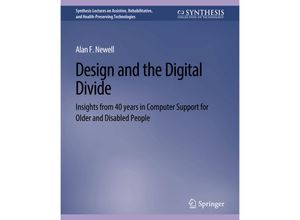Demographic trends and increasing support costs means that good design for older and disabled
people is an economic necessity as well as a moral imperative. Alan Newell has been described
as a visionary who stretches the imagination of all of us and truly ahead of his time. This
monograph describes research ranging from developing communication systems for non-speaking and
hearing-impaired people to technology to support older people and addresses the particular
challenges older people have with much modern technology. Alan recounts the insights gained
from this research journey and recommends a philosophy and design practices to reduce the
Digital Divide between users of information technology and those who are excluded by the poor
design of many current systems. How to create and lead interdisciplinary teams and the
practical and ethical challenges of working in clinically related fields are discussed. The
concepts of Ordinary and Extra-ordinary HCI User Sensitive Inclusive Design and Design for
Dynamic Diversity and the use of Creative Design techniques are suggested as extensions of
User Centered and Universal Design. Also described are the use of professional theatre and
other methods for raising designers' awareness of the challenges faced by older and disabled
people ways of engaging with these groups and of ascertaining what they want rather than just
what they need. This monograph will give all Human Computer Interaction (HCI) practitioners and
designers of both mainstream and specialized IT equipment much food for thought. Table of
Contents: 40 years--Highlights and a Brief Review Communication Systems for Non-Speaking and
Hearing-Impaired People TV Subtitling for Hearing-Impaired People Word Prediction for
Non-Speaking People and Systems for those with Dyslexia Providing Reusable Conversation for
Non-Speaking People Story Telling and Emotion in Synthetic Speech Lessons Learned from
Designing AAC Devices IT Systems for Older People Designing IT Systems for Older People
Ordinary and Extra-Ordinary Human Computer Interaction User Sensitive Inclusive Design The
Use of Professional Theatre Attacking the Digital Divide

